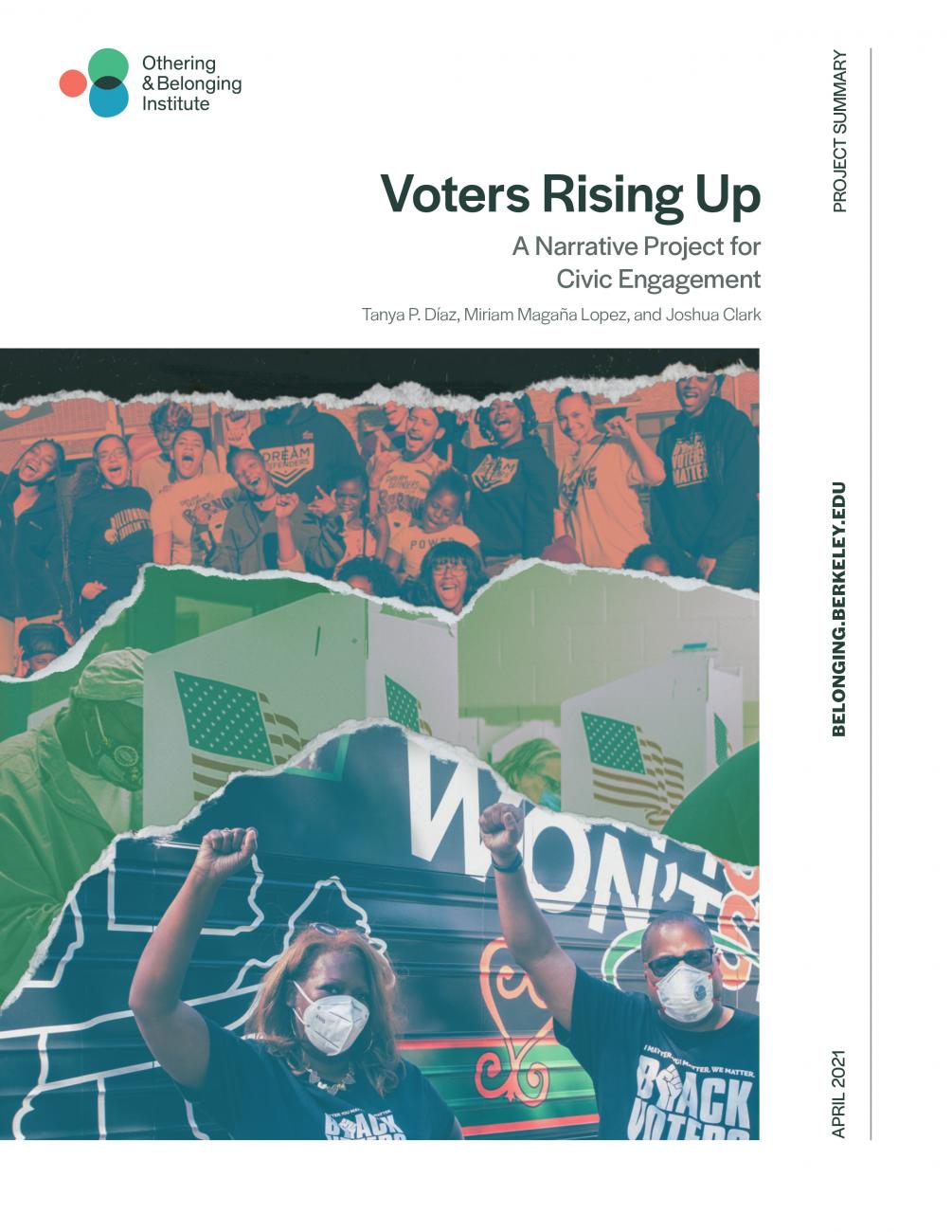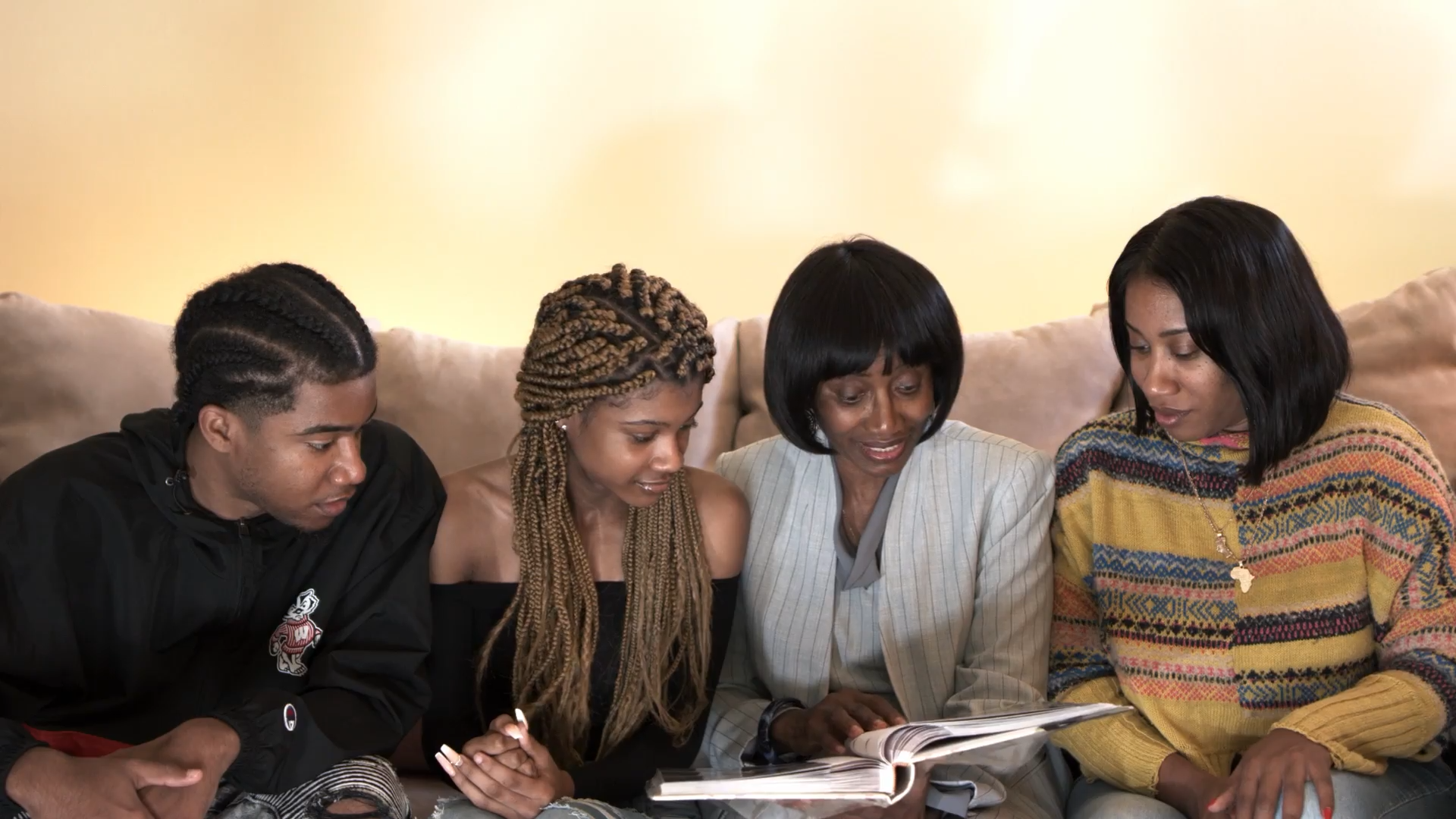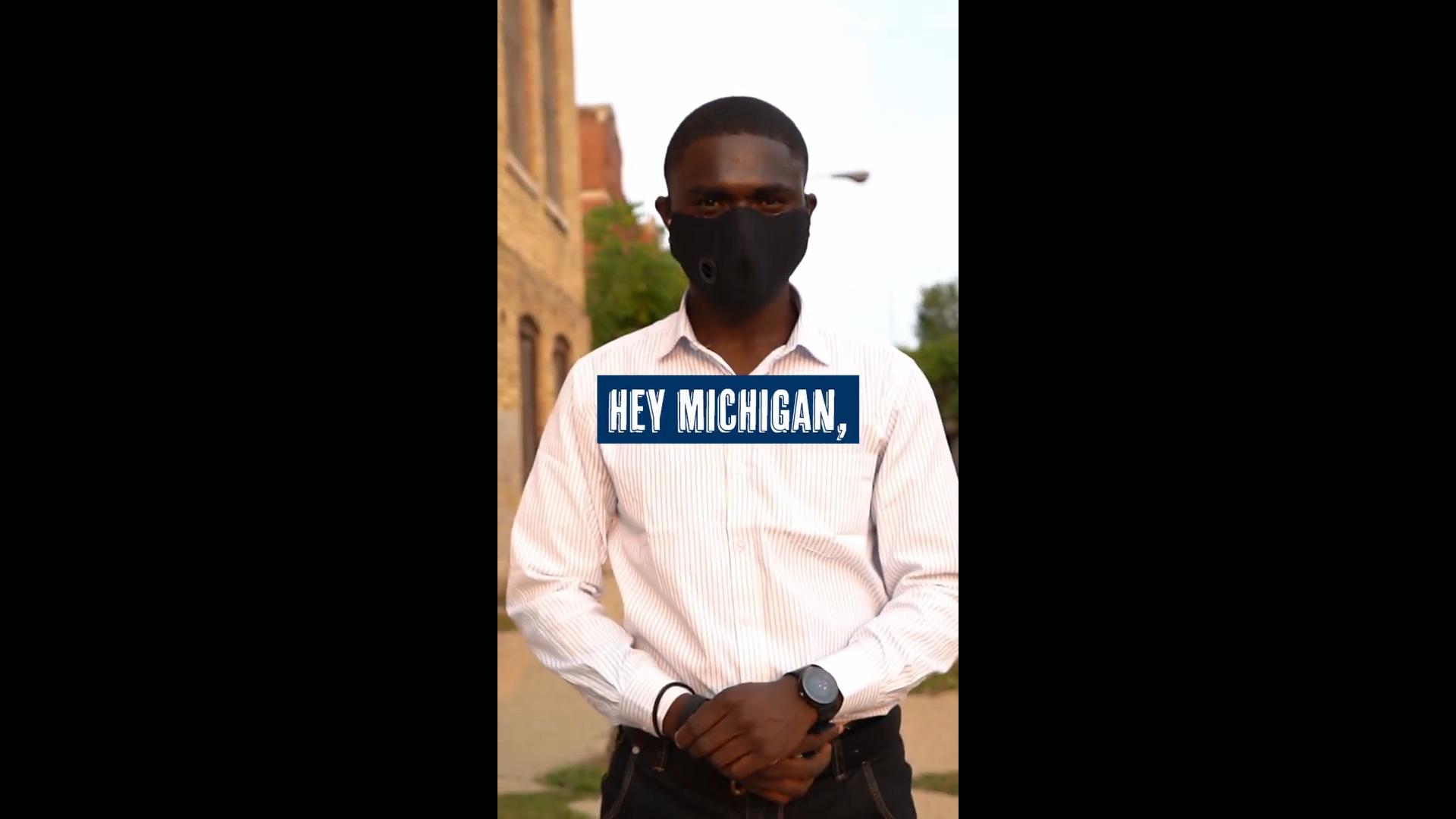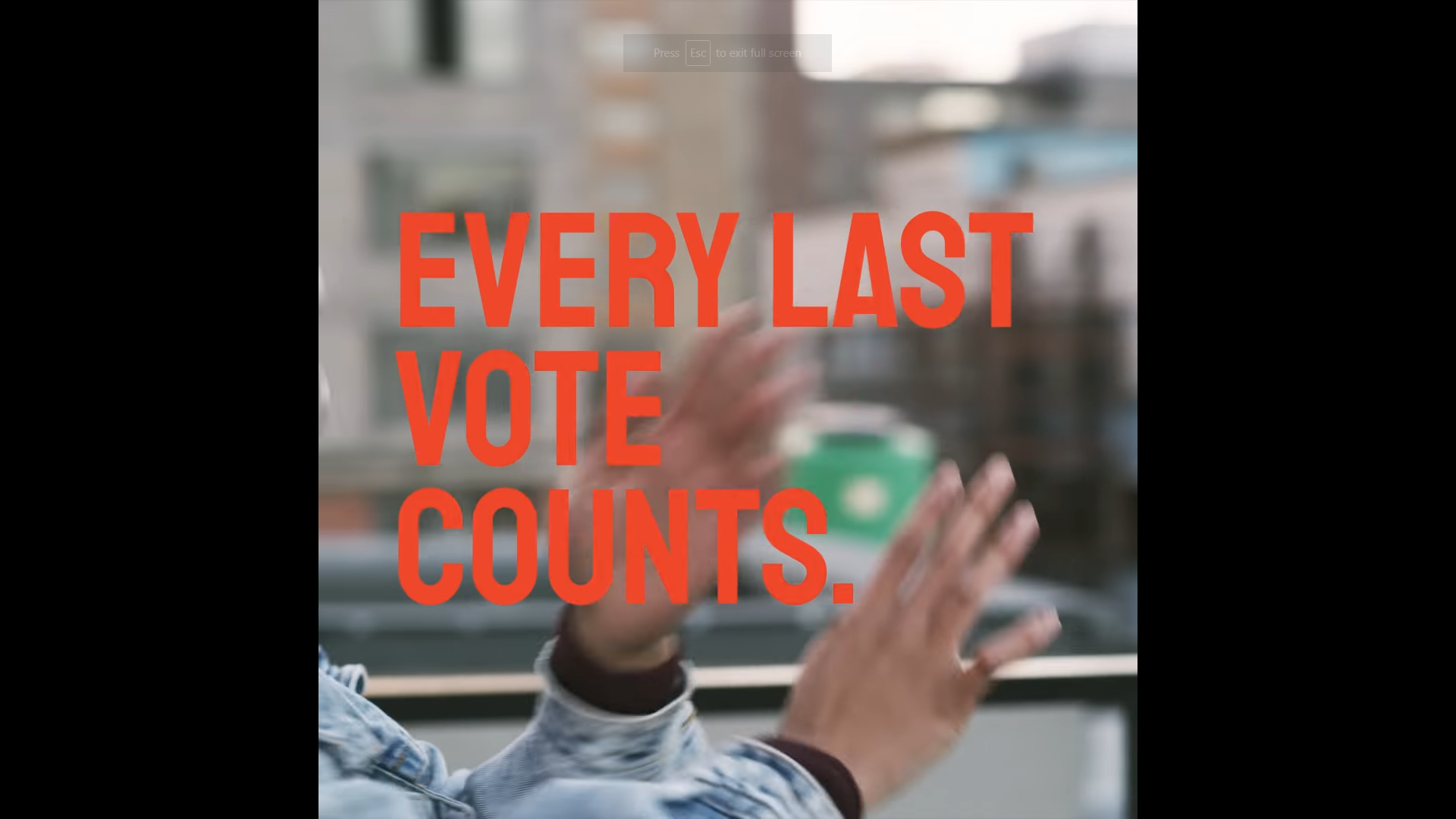Voters Rising Up: A Narrative Project for Civic Engagement
This report reviews the central work of the newly founded Rise Up for Justice Narrative Hub. The Hub brought together researchers, strategists, creatives, and digital communication specialists to support the civic participation of underrepresented groups and engage some of the leading Black- and Latinx-led power building organizations across the country. The authors detail the innovative model crafted by the Hub in get-out-the-vote campaigns leading up to the 2020 general election and 2021 Georgia Senate runoff elections.
Click here to download the report "Voters Rising Up: A Narrative Project for Civic Engagement."
Introduction
Building on the success of its Civic Engagement Narrative Change project, in 2020, the Othering & Belonging Institute (OBI) dramatically expanded its work to support the civic participation of underrepresented groups. At the center of this work was the newly founded Rise Up for Justice Narrative Hub. The Narrative Hub was led by researchers and strategists at the Institute, together with creatives and digital communication specialists, to engage some of the leading Black- and Latinx-led power-building organizations around the country.
This report details the innovative model and deliverables of the Rise Up for Justice Narrative Hub’s get-out-the-vote (GOTV) campaigns for the 2020 general (presidential) elections and the January 2021 Georgia Senate runoff elections.
For the 2020 general election, the Narrative Hub developed research-based digital content, digital and traditional ad campaigns, and creative offline campaigns to support organizing efforts in Nevada, Arizona, Wisconsin, Michigan, Georgia, North Carolina, Illinois, and California. All told, the Rise Up for Justice Hub reached millions of voters across the country through its digital campaigns, and hundreds of thousands more in offline campaigns.
When partner organizations turned to Georgia’s special Senate runoff elections in January 2021, the Hub pivoted with them, developing partner-driven messaging, creative digital content, and a paid ad campaign to support GOTV efforts reaching over 64,000 voters.
Context
The 2020 elections came on the heels of a historically high-turnout midterm in 2018, and the Narrative Hub sought to support the many grassroots and movement-based organizations building on that momentum. At the same time, the COVID-19 pandemic posed steep challenges for reaching historically underrepresented communities like Black and Latinx voters, and young and first-time voters. Not only had the pandemic hit these communities particularly hard, but the risk of transmission also limited civic organizations’ ability to use the best approach to activating inconsistent voters from these communities: in person, multi-touch relational organizing.
Simultaneously, the pandemic also altered options for how people could vote, necessitating an added layer of voter education. Most notable was a sudden increase in the availability of, and need for, mail ballot voting options. In most states, mail ballots had been used by only a small minority of voters prior to 2020, and their expansion came with dizzying rounds of policy debate and rule changes.
These considerations were the backdrop against which the Othering & Belonging Institute and its civic partners made the strategic decision to form the Rise Up for Justice Narrative Hub, with a focus on meeting the digital-organizing demands of the moment.
The Narrative Hub Model
Drawing on OBI’s strategy brief “From Estrangement to Engagement: Bridging to the Ballot Box,” this innovative venture encompassed a space for aligning over fifteen key civic and power-building organizations working across the country and in critical states. OBI’s team, collaborating partners, and a creative content-production firm met weekly to develop research-based GOTV narrative strategies and tactics. The Hub was built into a forum for generating multimedia assets and tools built around resonant messages and imagery, with a platform for extended networks to access and use these products in their campaigns.
A core group of partners activated to convene regularly, advise strategy, and approve content and specific messaging based on their organizing efforts on the ground. These collaborators included:
- Black Voters Matter Fund
- Coalición de Derechos Humanos
- Elect Justice
- Make the Road Nevada
- Metropolitan Organizing Strategy Enabling Strength (MOSES)
- One Fair Wage
- Racial Equity Collaborative
- Revolve Impact
- Service Employees International Union (SEIU)
- We The People Michigan
- Workers Center for Racial Justice
Many members of the Institute’s wider, multi-sectoral partner networks also contributed to strategy and content development and dissemination. These included our national- and state-level Civic Engagement Narrative Change partners and the What’s Next Network.
The Narrative Hub was announced through individual outreach and eNewsletter communication to over 450 organizers across the country. Regular eNewsletters were sent over the next four months as the Hub developed and distributed content.
“A critical function of a healthy democracy is an engaged populace who votes. Yet the safe access to vote has long been a struggle for Black Americans and other people of color. In 2020, with the added concerns of COVID-19, the slowdown of the US Postal Service, and continued police violence against Black lives, there is even more risk of people dropping out.”
—Rise Up for Justice, Call to Action
Campaigns by the Numbers
The map below summarizes GOTV campaigns organized by the Rise Up for Justice Narrative Hub for the 2020 general election and the 2021 Georgia special election. OBI collaborated with community organizations across eight states to generate bilingual campaigns. The Rise Up Narrative Hub developed and tested messaging for use in advertisements and digital assets; the assets that performed best were distributed through paid social media and influencer strategy, and via organic shares by partner organizations.
In the data sheet below, we report the number of unique voters that each type of campaign reached whenever possible. When we cannot capture the number of unique voters, we report impressions instead—an estimate of the number of times the ad was viewed. In some instances, data could not be quantified or tracked. More details on each campaign can be found in the narrative below.

Campaign Tactics
2020 General Election
RISE UP FOR JUSTICE LIVESTREAM | Digital
OBI’s livestream series, “Rise Up For Justice: Black Lives and Our Collective Future,” engages Hub partners as movement experts as panelists and audience leading up to the election and beyond. The series was launched in June 2020 in response to the murder of George Floyd. A growing Black-led movement has demanded police accountability and justice, as well as galvanized anger, grief, and frustration over the repeated killings of Black men and women both historically and in the present day.
Four programs were held leading up to the election, creating space for live cutting-edge conversations among activists, scholars, journalists, and other thought leaders to provide context and analysis on this transformative moment, envision what comes next in the movement for racial justice, and generate hope for a future rooted in true belonging. Art, poetry and performance was woven into the programs in order to root these conversations in cultural practice. The series consisted of the following four programs:
1. Black Lives & Our Collective Future featuring
- Emira Woods, Africans Rising
- Linda Sarsour, Until Freedom
- Rev. Michael McBride, Faith in Action
- Daisy, Minnesota Immigrant Rights Action Committee
- DeAngelo Bester, Workers Center for Racial Justice
- Cat Brooks, Justice Teams Network
- Glenn Harris, Race Forward
- Greg Kelley, SEIU Healthcare Illinois and Indiana
- Nick Tilsen, NDN Collective
- john a. powell, OBI
- Poems performed by Glide Memorial Church Celebration Minister and poet, Marvin K. White
2. Athlete-Activists Elect Justice featuring
- Michael Bennett Jr., Athletes for Impact
- Rosalie Fish, runner and Indigenous activist
- Janelle Gary, New Generation
- Dave Zirin, political sports writer
- Andrea Hailey, Vote.org
- Jesse Hagopian, Black Lives Matter at School
- Mike de la Rocha, Elect Justice, Revolve Impact & Athletes for Impact
- Opening performance by Akeishein Wells
- Closing poem by Berkeley poet laureate Rafael Jesús González
3. Voter Suppression and the Right to Vote featuring
- LaTosha Brown, Black Voters Matter Fund
- Cliff Albright, Black Voters Matter Fund
- Brianna Brown, Texas Organizing Project
- Desmond Meade, Florida Rights Restoration Coalition
- Judith Browne Dianis, Advancement Project
- Gerald Lenoir, OBI
- Opening musical performance by LaTosha Brown
- Closing original poem by Gerald Lenoir
4. Covid-19 and the Political Determinants of Health featuring
- Ann C. Keller, UC Berkeley School of Public Health
- Alein Haro, UC Berkeley School of Public Health
- Rahwa Neguse, Healthy Black Families, Inc.
- James King, Ella Baker Center for Human Rights
- Axel Fuentes, Rural Community Workers Alliance
- Closing poem by Gerald Lenoir
- Original rap performed by middle-school musical group Triple S
PINTEREST CAMPAIGN | Digital
Pinterest Foundation donated their creative services to develop four GOTV digital pins, as well as credit for $150,000 worth of paid ads. Ads ran on Pinterest through the OBI profile. This national campaign was designed to reach Latinx people ages 19-49 nationwide in both English and Spanish. Unable to target by race/ethnicity directly, ads focused on users with shared interests in Mexican and Brazilian food recipes, and events like Dia de Los Muertos and Quinceañeras. OBI developed a presence on Pinterest for organic sharing.
- Reported reach: Nationwide results included 17,543,267 impressions and 64,165 clicks.
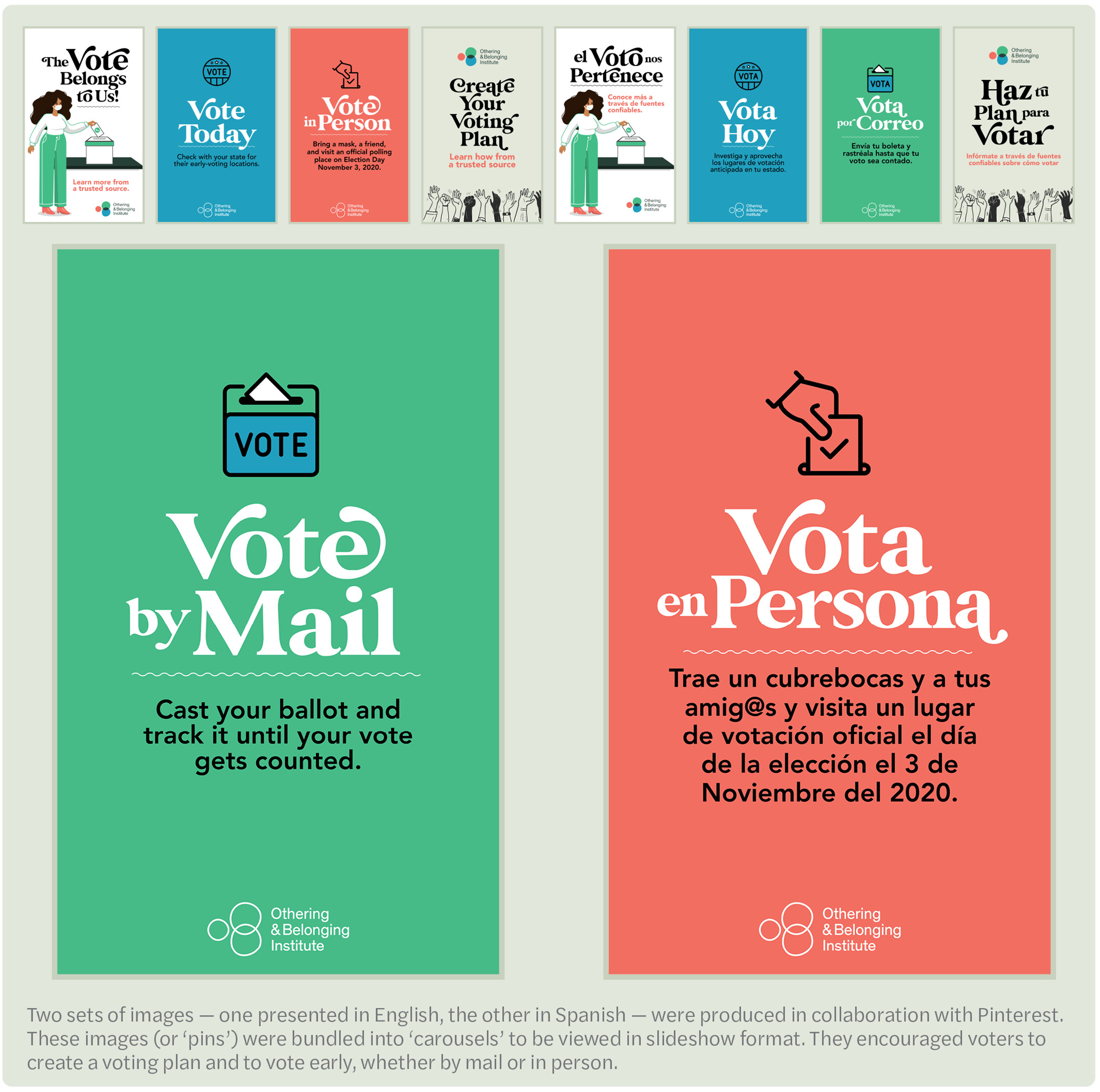
PSA VIDEO CAMPAIGN | Digital
Several videos were created in English and Spanish with key messaging to be strategically distributed in key states. These videos successfully reached targeted voters through paid social media ads, paid influencers, and organic social sharing.
Can You See It? This award-nominated motivational video for future change reached millions of voters across Michigan, Illinois, and California. As a 2021 Writers Guild Award–nominee, the video was used by partner organizations for organizing efforts along with paid digital and television ads.
- California: Partner organization California Calls reported that this video resonated very well with their labor and community partners. They used the video for major paid ad buys on Univision and Facebook.
Reported reach: 1,086,015 impressions and 624,727 views on Facebook, reaching 353,258 unique individuals. 6,160,239 impressions and 4,546,410 views on Univision.
- Illinois: Workers Center for Racial Justice (WCRJ) utilized the video for pre-campaign GOTV work. The Center for Racial and Gender Equity ran digital ads with the video starting in October 2020. Their media ads targeted Black voters statewide.
Reported reach: 35,960 people and the video had 70,914 views.
- Michigan: Restaurant Opportunities Center (ROC) Michigan and For Our Future Michigan utilized the video for limited pre-campaign GOTV work.
Reported reach: For Our Future Michigan posted the video on social media. On Facebook, the Spanish version had 166 views and the English version had 142. On Instagram, the English version had eighty-seven views. Numbers for ROC Michigan are not available.
Vote-By-Mail Explainers. Two animated instructional videos were created to guide voters through the vote-by-mail process, tailored to voting protocols in Michigan and Wisconsin. These were designed to encourage use of vote-by-mail and to decrease chances of errors that could lead to ballot rejection.
- Michigan: Partnering with Metropolitan Organizing Strategy Enabling Strength (MOSES) and We the People Michigan, videos in English and Spanish were developed for a paid Facebook ad campaign and organic social media sharing. Voter file targeting was used to reach young BIPOC low-propensity voters.
Reported reach: 14% of the total voter group reached. 42,944 voters reached and 191,787 impressions.
- Wisconsin: Workers Center for Racial Justice (WCRJ) collaborated on the creation and distribution of videos in English and Spanish. Voter files were used to reach young BIPOC low-propensity voters.
Reported reach: 27% of the total targeted voter group. 26,488 voters reached, 95,700 impressions.
Did You Know? #TrustBlackWomen. A storytelling short featuring African American postal worker Sandy Wilson and her grown children aimed to increase trust in the US Postal Service and voting by mail. The video and companion social media graphics reminded voters that a disproportionate number of postal workers are from Black communities, and that Black women have provided mail service for years and can be trusted to deliver your ballot.
- Michigan: Paid Facebook ad campaign with Black Voters Matter Fund. This effort brought high engagement with one ad resulting in 181 comments and 63 shares.
Reported reach: Video reached 67,000 voters, with 127,000 impressions. Social media graphics (3 versions) resulted in a combined 129,000 people reached, 134,097 impressions, and 36,000 clicks.
- Wisconsin: Paid Facebook ad campaign with WCRJ.
Reported reach: Video 33,000 voters reached and 71,000 impressions with 50% viewing rate. Social media graphics (3 versions) resulted in 120,000 people reached, 1.2 million impressions.
Hey ! Social media video shorts using music and dance created for 24-hour viewing on Instagram stories in Georgia, Michigan, North Carolina, and Wisconsin. These were distributed as paid ads with Workers Center for Racial Justice, local micro-influencer posts, and organic sharing by in-state partner organizations.
- Hey Georgia!:
Reported reach: 149,500 individuals reached with 255,000 impressions. Ten Georgia-based social media influencers also posted these shorts in their Instagram stories reaching up to 300,000 followers.
- Hey Michigan!:
Reported reach: 110,000 individuals reached, with 155,000 impressions. Five social media influencers shared these posts, reaching up to 126,000 followers.
- Hey North Carolina!:
Reported reach: 93,600 individuals reached, with 150,000 impressions. Five social media influencers shared these posts, reaching up to 186,000 followers.
- Hey Wisconsin!:
Reported reach: 52,000 individuals reached, with 71,000 impressions. Eight social media influencers shared these posts, reaching up to 348,000 followers.
Why I’m Voting. These well-received selfie testimonial videos and accompanying social media messages targeted Latinx communities in English and Spanish. These videos featured actual new voters—identified by partner organization Make the Road NV—who filmed themselves speaking about voting for the first time, for those who are not able to vote, and for family and community. The campaign was so successful that it quickly expanded into offline ad campaigns in Nevada and Arizona, including billboards and screens at point-of-sale bodega locations in the same states—discussed later in this report under the “Billboard Campaign” and “Stores Campaign” sections.
- Nevada: Paid ad campaigns were run with Make the Road Nevada.
Reported reach: 145,000 voters reached, with 1,004,243 impressions.
Super Voters. Partnering with Black Voters Matter Fund, this GOTV video played on a Halloween theme encouraging viewers to be a “super voter” rather than a superhero. These videos launched nine days prior to election day in five key states—Arizona, Georgia, Michigan, North Carolina, and Wisconsin. In total, it was viewed over 1.7 million times, reaching over 310,000 people with a frequency of five views each. Wisconsin voters saw the video the most, at 9.7 times each.
- Arizona:
Reported reach: 53,152 voters reached, with 340,730 impressions.
- Georgia:
Reported reach: 56,337 voters reached, with 201,329 impressions.
- Michigan:
Reported reach: 64,831 voters reached, with 260,171 impressions.
- North Carolina:
Reported reach: 95,183 voters reached, with 527,172 impressions.
- Wisconsin:
Reported reach: 40,000 voters reached, with 387,920 impressions.
Counting the Votes. Using the theme of “don’t leave before the encore,” this post-election video explained the process of vote counting in order to normalize November as “counting month.” Messaging emphasized the need to count every vote before anyone could claim final election results. The video was distributed nationally through organic social media sharing.
STATIC GRAPHIC AD CAMPAIGN | Digital
Using mostly Vote.org tools, OBI staff worked with partner organizations to create GOTV landing pages for each ad campaign. These pages included information on deadlines, instructions for voter regististration, guides to request a ballot or vote in-person, and other resources. Partners included the Center for Racial and Gender Equity, Black Voters Matter Fund, Coalición de Derechos Humanos, and Make the Road NV. Other partners linked directly to their state voter registration pages or the Rise Up for Justice Hub’s landing page.
- Arizona: Three static ads—each in English and Spanish—were created with Coalición de Humanos Derechos. With their guidance, the campaign targeted their base of progressive Latinx voters, encouraging those who were unsure about participating in 2020 to vote. Top performing messages and images included an ad featuring an Indigenous couple with a message about redefining what safety means, and an image of a protest with a message calling on people to vote on behalf of those who have been silenced.
Reported reach: 138,000 voters reached, over 958,000 impressions.
- Michigan: The Hub created an array of static content to educate voters on important voting information for a paid Facebook ad campaign with partners MOSES and We the People. When measuring engagement, the best performing ad was the “October is Voting Month.” This piece of content also saw the most on-ad engagement of the entire corpus of OBI static ads with 2,020 likes, 186 shares, and 174 comments.
Reported reach: 186,447 voters reached, 602,027 impressions.
- Nevada: Three static ads in English were launched using “Why I’m Voting” content. These went out through Make the Road NV’s Facebook and Instagram accounts targeting low-propensity Latinx voters.
Reported reach: 79,616 voters reached, 339,558 impressions.
- Wisconsin: “October is voting month” and “Vote early” messages were created for the ad campaign with Wisconsin partner WCRJ.
Reported reach: 109,687 voters reached, 868,463 impressions.
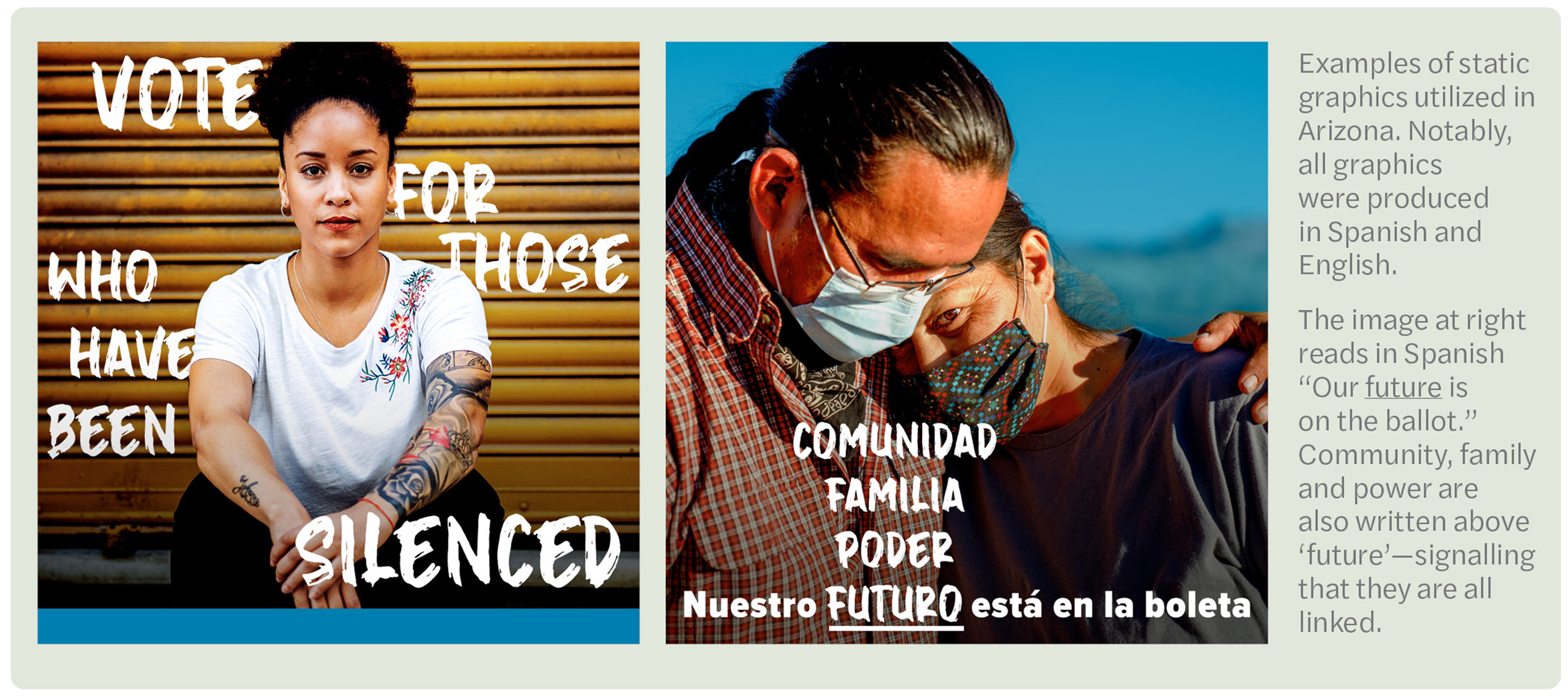
ORGANIC SOCIAL MEDIA | Digital
Digital content for rapid response and proactive social media was created and uploaded to an asset library using The Social Press Kit online platform for organic sharing. OBI shared a weekly/twice-weekly eNewsletter with the Narrative Hub and larger list of partner organizations highlighting the latest graphic stills, GIFs, videos, social-media messaging, and relevant news articles. Content was uploaded to a digital library tool for accessibility. The Hub also helped amplify One Fair Wage’s national Elena the Essential Worker campaign.
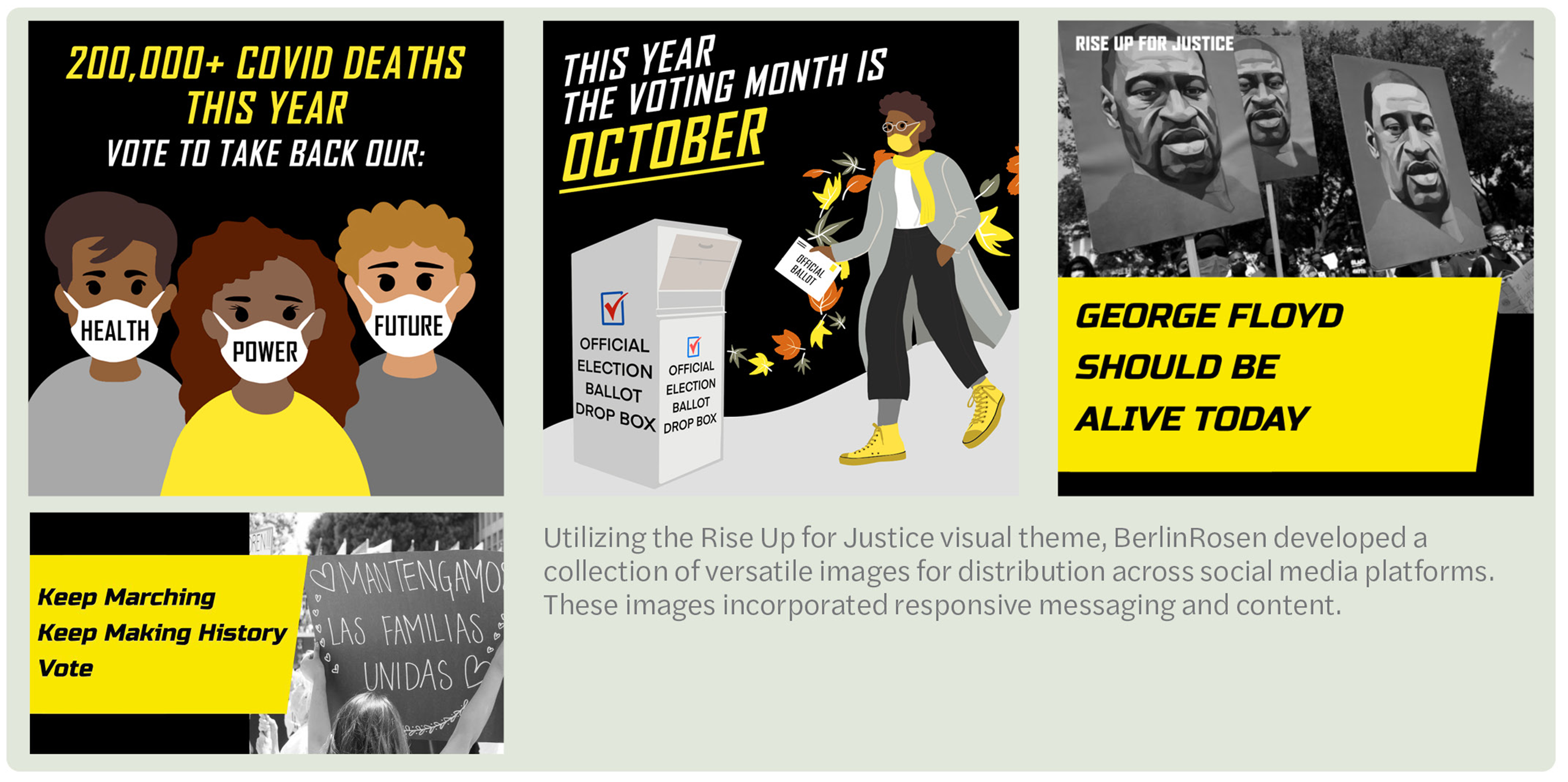
RADIO CAMPAIGN | Offline
Radio spots were created to run in Arizona and Nevada, reaching Spanish- and English-speaking audiences during the final weeks of the general election.
- Arizona: In collaboration with Coalición de Derechos Humanos, OBI ran radio ads from October 27 until November 2. The first round of radio ads played thirteen times on KOY-AM (Spanish) and six times on KYOT-FM (English). Later, OBI and Coalición de Derechos Humanos were informed that the ads would need to include a financial disclosure statement. The script was then edited, and the second version played eighty-five times on KOY-AM (Spanish) and nine times on KYOT-FM (English). To estimate the reach of radio campaigns, Nielsen reports of average listener data were used as the basis of calculations.
Estimated reach: 404,000 impressions.
- Nevada: In collaboration with Make the Road NV, OBI ran radio ads from October 20 until November 2. The first round of radio ads played nine times on KYMT-FM (Spanish) and thirteen times on NYMT-FM (English). OBI and Make the Road NV later created an updated version with financial disclosures, which played thirty-one times on KYMT-FM (English) and sixty-five times on NYMT-FM (English). To estimate the reach of radio campaigns, Nielsen reports of average listener data were used as the basis of calculations.
Estimated reach: 234,000 impressions.
BILLBOARD CAMPAIGN | Offline
Using the “Why I’m Voting” campaign content, OBI ran billboards from October 19 until November 2 along freeways in Las Vegas and Phoenix. A formula was generated based on number of cars passing by and the average number of passengers per car in order to calculate the reach of the billboard campaigns. Approximately half of the advertisements were viewed in Spanish and the other half in English.
- Phoenix, AZ: Partnered with Coalición de Derechos Humanos.
Reported reach: 1,907,000 impressions
- Las Vegas, NV: Partnered with Make the Road NV.
Reported reach: 1,616,000 impressions
STORES CAMPAIGN | Offline
Again leveraging content from the “Why I Vote” campaign, OBI ran point-of-sale advertising in fifteen bodegas in Arizona and Nevada from October 18 until November 2. To measure reach, a formula based on the average number of transactions per day was used. Approximately half of these digital ads—located on a screen at checkout counters—were viewed in Spanish and the other half in English.
- Arizona: Partnered with Coalición de Derechos Humanos
Reported reach: 245,000 impressions.
- Nevada: Partnered with Make the Road NV
Reported reach: 105,000 impressions.
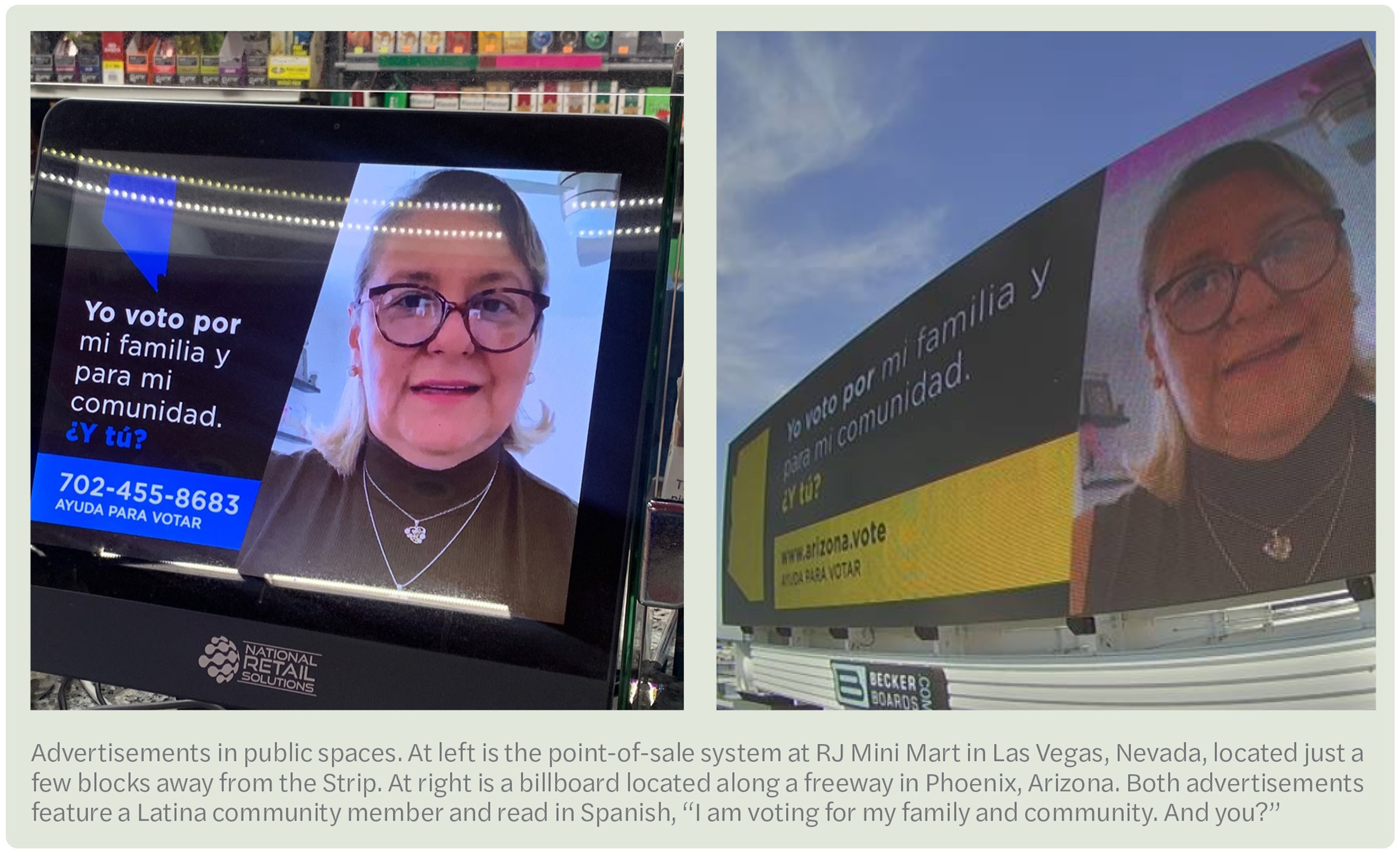
SCHOOL PSA SCRIPTS | Automated
GOTV scripts were written to be read on existing robo-call lines to school families in English and Spanish. Scripts were tailored to specific GOTV messages in each state.
- Arizona: OBI reached out to the three largest school districts in the state: Mesa Unified School District, Chandler Unified School District, and Tucson Unified School District. A Chandler Unified representative replied thanking us for the resource, but it is unconfirmed whether it was utilized.
- California: OBI reached out to various California School school districts. Teachers for Social Justice and schools in West Contra Costa Unified School District published the script in their newsletters. Individual reach could not be captured.
- Nevada: OBI shared the script with Clark County School District, the largest district in Nevada, but it is unconfirmed whether it was utilized.
- Michigan: OBI shared the script with seven school districts and PTA groups. The OBI team met with Sherisse Butler from the Government & Community Affairs team in Detroit Public Schools to share the script and other GOTV tools. Additionally, OBI connected Sherisse Butler with two community partners in Detroit to create a Michigan specific text message tool.
- Wisconsin: OBI shared the script with thirteen charter schools, schools districts, and PTA groups in the state. Kenosha School District, which has 21,233 students, posted the resource on its virtual resource page. Milwaukee Public Schools Foundation forwarded the script to district leadership. Individual reach could not be captured.
EDUCATION & CAPACITY BUILDING PROJECT | Offline
In June 2020, the OBI team launched the Cultural Initiative for Voter Information and Civic Strength (CIVICS) project in California. CIVICS involved partnership with Alianza Coachella in Riverside County; Loud 4 Tomorrow in the San Joaquin Valley, and Resilience OC in Orange County. Both organizers and artists participated in this partnership, attending a week of online sessions hosted by the OBI team and the Center for Cultural Power.
Sessions included training units on cultural strategy, strategic narrative, and bridging, and hands-on project development for GOTV efforts. The objective was to get young people to envision a new political and social arrangement that values them and their families, and to move them to participate in making that vision a reality.
2021 Georgia Senate runoff election
In Georgia, two November 2020 senate elections failed to produce a winner with fifty percent of the vote, triggering run-off elections to be held on January 5, 2021. The Narrative Hub remained active to support partners—both established and new—through these elections. It collaborated most closely with Black Voters Matter Fund, Black Alliance for Just Immigration (BAJI), and Asian Americans Advancing Justice-Atlanta to develop and test messages, run ads through Black Voters Matter Fund’s Facebook and Instagram pages, and disseminate social media content organically.
Knowing ad markets in the Atlanta metro area would be saturated, the campaign focused on inconsistent voters in medium-size cities along with places facing controversial poll closures. This tactic mobilized voters who were less likely to be reached while avoiding having ads buried in Atlanta’s tight market. Using TargetSmart data, a curated list was developed of BIPOC voters ages 18-34 who voted in the 2020 election but not in 2016. The initial focus was on Chatham (Savannah), Richmond (Augusta), and Cobb counties. During the third week of the campaign, ad reach was optimized by adding diverse suburban Clayton and Gwinnett counties.
SOCIAL MEDIA AD CAMPAIGN | Digital
The paid advertising campaign was launched on December 5, 2020, with five different messages by Black Voters Matter Fund featuring groups of energized Black voters and families at GOTV events holding signs and wearing BVMF t-shirts. The Facebook and Instagram campaign ran in five counties and saw incredible engagement rates in Chatham and Richmond Counties. The messages that saw highest engagement rates were those focused on COVID-19 relief and healthcare access.
- Reported reach: 64,000 voters, with 1.3 million impressions.
ORGANIC SOCIAL MEDIA CONTENT | Digital
Proactive social media content was developed in six different languages to be shared by organizers working in Asian American, African American, and Latin American, and immigrant communities. An eNewsletter was used to disseminate content and amplify partners’ campaign efforts. These included #postthepeach, BAJI volunteer recruitment, and BlockPower campaigns.

Key Takeaways
The Rise Up Narrative Hub allowed OBI and community partners to reach voters in key states during the 2020 presidential election, and in smaller markets with tight targeting in the 2021 Georgia senate runoffs. The Narrative Hub’s efforts for authentic engagement, culturally-appropriate messaging, and resonance with communities’ most urgent concerns built trust in ad campaigns and resulted in effective engagement. Below are key strategies that allowed for content to successfully reach our target audiences.
General election
Local storytelling. Between creative content, targeting, and messaging, each campaign was customized to fit specific landscapes. Our unique collaboration with local partners engaged in GOTV field operations helped us make these customizations seamlessly, contributing to the overall success of the campaigns.
Voter-file targeting. The use of voter-file targeting allowed us to identify and reach the young BIPOC voters most in need of voter education and motivation content in each state.
Leverage creativity. Working with two creative firms BerlinRosen and Render Tech, creative advertisements produced with local partner input resulted in high engagement. Additionally, authentic images of local voters and bilingual ad copy effectively communicated the stakes of the election.
Bilingual content. English and Spanish content across platforms and assets resulted in high engagement rates. In some cases (e.g. Nevada campaigns), there were higher engagement rates across Spanish-language content than English.
Short form video performs best. While longer-form video works for explainer/educational formats, the shorter form (15-30 seconds in length) consistently outperformed the 60-second videos.
Recognizing offline opportunities. The OBI team and Hub partners creatively partnered and quickly responded to needs and opportunities for non-digital ways to reach voters. Campaigns like scripted robo-calls to school phone lists, paid radio spots, point-of-sale advertising, and billboards reached voters in multiple places, greatly extending the reach of campaigns in key communities.
Georgia Senate runoff elections
Reaching the right voters at the right time. The outstanding performance of ads targeting voters outside the Atlanta metro validates the strategic choice to prioritize BIPOC voters in medium-size cities. In Chatham County, for example, the Hub’s campaign shattered Facebook’s regular engagement rate of 1% with a score of 83%.
Black Voters Matter Fund partnership. This campaign is another case study in the importance of our collaborative relationships with local partners, as well as the positive effect of their brands. The Hub shaped our graphics around BVMF’s brand identity, and used the organization’s photos of local voters. These deserve substantial credit for the overall success and high engagement rates of our ads.
Resources
Over the course of these GOTV campaigns, OBI and our partners developed an expansive array of literature — including research reports, strategy memos, and messaging guides. Click through the links below to access these texts.
- Contested Election Scenarios and Strategic Responses
- Facing November 3, and the Counting of the Votes
- “From Estrangement to Engagement: Bridging to the Ballot Box” by Olivia Araiza, Joshua Clark, and Gerald Lenoir
- Georgia GOTV: Senate Talking Points for Rise Up Georgia Hub
- Messaging for Potential Scenarios Post-Election Day
- Setting and Responding to Post-Election Narratives
Credits & Acknowledgments
Thank you to all of the Rise Up Hub participants and their networks throughout the country who dedicated time, expertise, insight, and organizing efforts to the success of these campaigns and record breaking election turnouts.
We also thank our funders who have made the work outlined in this report possible: The Schwab Charitable Fund made possible by the generosity of the Present Progressive Fund, Ford Foundation, Open Society Foundations, Marguerite Casey Foundation, The California Endowment, Blue Shield of California Foundation, W.K. Kellogg Foundation, and SEIU.
PROJECT TEAMS
Othering & Belonging Institute
Emnet Almedom, Research Analyst
Olivia E. Araiza, Program Director
Joshua Clark, Political Participation Analyst
Tanya P. Díaz, Special Projects Coordinator
Sara Grossman, Campaigns Coordinator
Ayketa Iverson, CE Program Coordinator
Gerald Lenoir, Identity and Politics Strategy Analyst
Miriam Magaña Lopez, Research and Policy Analyst
john a. powell, Othering & Belonging Institute Director
Amy Chen
Robbie Dornbush
Carly Neubauer
Quincey Smith
Aaron Walker
Dr. Robert “Biko” Baker
Robert Williams
LAYOUT, DESIGN & GRAPHICS
Erfan Moradi
IMAGE CREDITS
Illustrations used in “Campaigns by the Numbers” and thereafter by Tyler DeHauge, Simon Stratford, Creative Stall, Vectorstall, Fauzuan Adiima, mardjoe, Phonlaphat Thongsriphong, Designify.me, and Fahmihorizon
Images in cover art courtesy of Phil Roeder and the Black Voters Matter Fund
RECOMMENDED CITATION
Díaz, Tanya P., Miriam Magaña Lopez, Josh Clark. “Voters Rise Up: A Narrative Project for Civic Engagement.” Othering & Belonging Institute, University of California, Berkeley: Berkeley, CA. April 2021.
